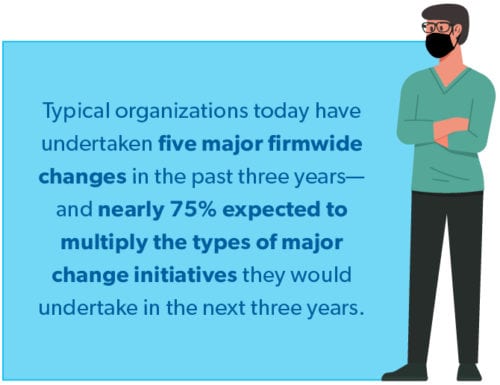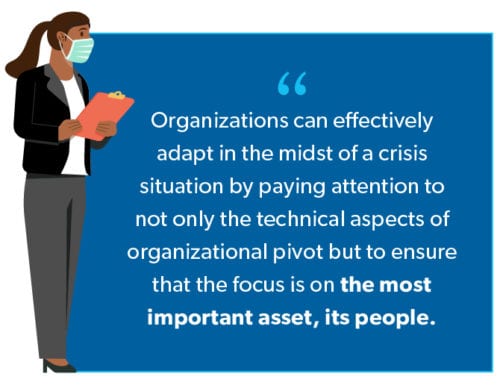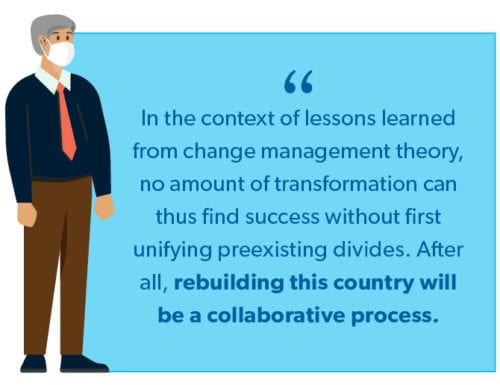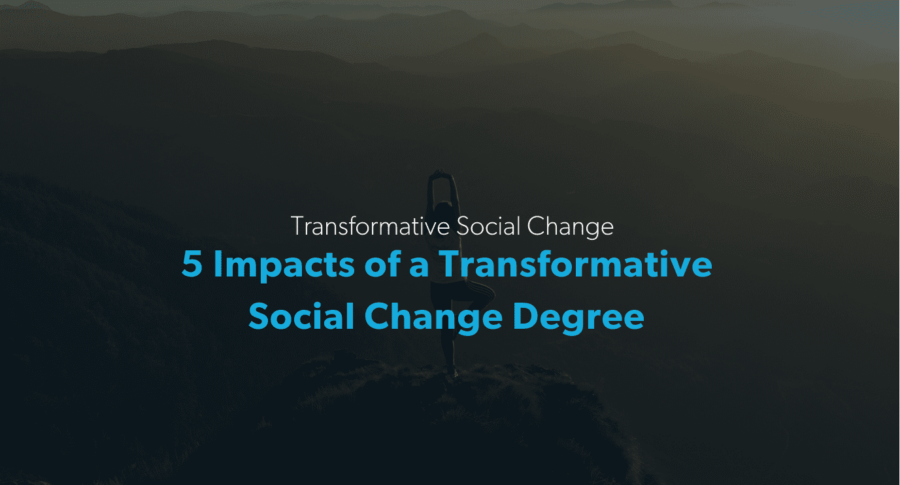2020 has been a year of compounding catastrophes. As of this writing in November, the COVID-19 pandemic has killed hundreds of thousands of Americans, and the economic ramifications have leveled families, businesses, and entire industries. In parallel, the country is experiencing a long overdue reckoning on racial justice as citizens express outrage at the continued lack of accountability for police officers who harass and assault communities of color.
How to adapt to changes, and to ultimately overcome such adversity, is a prospect with which many industries, including the business world, are all too familiar. In 2019, Gartner, a management consulting firm, surveyed business leaders and found that typical organizations today have undertaken five major firmwide changes in the past three years—and nearly 75% expected to multiply the types of major change initiatives they would undertake in the next three years.

From rebranding to new leadership to major pivots of their business models, millions of organizations around the globe endure large-scale institutional change. To navigate through these times of uncertainty, knowledgeable executives practice “change management,” a process Harvard Business School defines as “the method of leveraging change to bring about a successful resolution.” In fact, in 2017 businesses spent more than $10 billion dollars on change management consultancy.
As 2020 draws to a close, it is not that difficult to see the United States as a giant corporation undergoing organizational change—all the while enduring a global pandemic. Is it possible to apply the tenets of change management to how we might adjust as a country and ultimately prevail?

What makes the current state of global affairs in the midst of the novel coronavirus pandemic particularly stressful is the degree of uncertainty.
And there is no easy fix, no “cure” around the corner that can be implemented and become effective. Even with a safe and successful vaccination, the speed of distribution and the pace at which the economy will recover are both still in question. A September 2020 Pew Research Center poll found that only 51% of U.S. adults said they would “definitely or probably get a vaccine to prevent COVID-19 if it were available today,” with 49% saying they “definitely or probably would not get vaccinated at this time”—a reluctance many attribute to the politicization of the vaccination process.
“The polarized mind is about a fear-driven move toward the perception of absolutism, certainty, and sameness,” says Kirk Schneider, Ph.D., psychology faculty member at Saybrook and author of The Depolarizing of America: A Guidebook for Social Healing. “This is why people who are polarized tend to cluster in groups of people who are similar to them. You have these echo chambers and cultural silos because they feel safer.”
But in addition to bridging divisiveness, the fact remains: Much about the near future is unknown. During times of extreme uncertainty—no matter the reason—Tom Hayashi, Ph.D., chair and program director of the Department of Leadership and Management at Saybrook University, believes an “adaptive leadership” approach is the best way forward.
In short, it requires thinking on your feet, coalition building, and taking ownership while addressing the people factor—all tactics that Dr. Hayashi has found fruitful in his consultations and research in the field with organizations during COVID-19.

Part of most action plans right now include moving services online—but they also need to include holding conversations with all participants in the decision-making process, which makes a significant difference in how programs are implemented.
“Plans should be in response to external and internal customers. A way to, in real time, display adaptive strategies and leadership,” Dr. Hayashi says. “Organizations can effectively adapt in the midst of a crisis situation by paying attention to not only the technical aspects of organizational pivot but to ensure that the focus is on the most important asset, its people. Research in change management has consistently shown that dedicated attention and investments in the capabilities of the workforce such as leadership and team coaching as an integral part of systems and process adjustments can significantly enhance productivity by 30% and reduction in attrition by as much as 50% … ultimately effective adaptive leadership translates to positive people and profit outcomes when organizations can really use every break they can get in times of the global pandemic.”

Another key component of effective change management is diversity: diversity of thought, diversity of identity, diversity of talent. By incorporating such diversity into a group tasked with making change, leaders have access to a wider variety of perspectives and, in turn, can adjust their strategies accordingly.
Think of it this way: In a work environment, if employees don’t feel understood or valued, then culture, productivity, and retention can suffer. In fact, a 2018 report from McKinsey and Company found that public companies in the top quartile for ethnic and racial diversity in management were 35% more likely to have financial returns above the industry average, and those in the top quartile for gender diversity were 15% more likely to have returns above the industry average.
For both government officials and business executives, the proof is in the pudding: When leaders invest in diversity, it pays dividends.
“One of the phrases I use with my clients is ‘Be a listening, learning leader,’” says Saybrook University Board Trustee Joanne L. Smikle, Ph.D. “Do not walk in pretending that you know it all, that you have all the insights in the world, and that you are the fount of all knowledge. Leaders have to be open to hearing different perspectives. It’s important to find and prioritize fresh voices.”
It’s a widely accepted tactic of adopting changes in business to listen to those who the change is going to affect—aptly named an open-source approach. By ensuring diverse voices and making them a part of conversation, research shows that successful implementation grows by 22%.
“I think people need not fear what they have a voice in,” Dr. Smikle adds. “So the question is, ‘What are you going to do to actively solicit input and insights from lots of different people?’ It’s like when I work with clients on strategy, I say, ‘Do not think because you are an executive at this company that you are necessarily the best person to guide strategy or know what is best for the organization. The people close to the work have a level of intelligence that the people at the top of the house don’t have. Let’s hear from those people. Let’s invite them into these strategy sessions. Let’s invite them to shape the future of this organization.’ It’s the same model for this country.”

One of the resonating values of civil progress has long been increasing the voices that are heard—and it’s easy to understand that as a nation, our success with dealing with these rapid changes is much more likely to be successful by incorporating valuable insight from all communities.

The American Society of Quality defines change management as “the methods and manners in which a company describes and implements change within both its internal and external processes. This includes preparing and supporting employees, establishing the necessary steps for change, and monitoring pre- and post-change activities to ensure successful implementation.” Noting that the reason most changes fail are human reasons.
Change does not happen in a vacuum.
Success and failure are largely dependent on whether or not key constituencies buy into the premise. Within an organization, employees can be resistant to change, as the status quo is oftentimes more comforting than the prospect of the unknown.
Causes for fear are abundant in today’s world, made exponentially worse by the uncertainty of it all. We don’t know how many people will perish before a viable COVID-19 vaccine emerges, or whether local, state, and national governments will actually move forward to address the racial injustices laid bare over the course of many years—not just 2020. If the unknown and uncertain inherently predispose us to fear, then it’s no wonder anxiety is at an extreme high for so many.

These dual pandemics—COVID-19 and racism—are now responsible for a sort of collective trauma. A recent CNN investigation considers the impacts that mass trauma can have on a population by revisiting the prolonged state of “chronic threat response” (the ongoing state of being in survival mode) provoked by the events of September 11, 2001. According to the World Trade Center Health Registry, roughly 20% of registrants reported PTSD symptoms many years later, indicating that the aftereffects of the coronavirus could be equally enduring.
Generations are brought together by these collective experiences while such a precarious environment also has the potential to drive individuals into polarized cultural vacuums, where oversimplified answers (think so-called miracle “cures” like hydroxychloroquine) are offered as confident, comforting explanations to complex and confusing questions.

In the context of lessons learned from change management theory, no amount of transformation can thus find success without first unifying preexisting divides. After all, rebuilding this country will be a collaborative process. The message of “together we can fix it” is sure to have a much broader appeal than the long-standing “only I can fix it” idea.
“Before change, there must be healing,” Dr. Smikle says. “You are not going to get buy-in in a fractured organization. You need to understand who your constituency is, work to strengthen those relationships, and once you’re sure those relationships are strong, work on cultivating new relationships.”

Between March 1933 and June 1944, President Franklin Roosevelt gave 30 fireside chats, intimate addresses broadcasted on radios across the U.S., on topics ranging from unemployment and economic policy to the looming threat of fascism. In the early days of mass media, it afforded the president a way to communicate directly with the public, securing support for the ambitious agenda of his first 100 days in office.
Such regular, informal entreaties allowed Roosevelt to exhibit accountability through transparency, as Dr. Hayashi suggests, and to showcase his skills as a listening, learning leader, as Dr. Smikle advises. He offered clear-cut plans to ease collective fears and referred to the American public directly as “you,” speaking openly and frankly about shared values—working to break down the divides of Dr. Schneider’s “polarized mind.”
The idea of applying business values to our current cultural issues is one of the founding principles of Saybrook’s new MBA and DBA programs. With the new Sustainable Social Impact MBA and DBA degrees, the university continues doing the work toward a more equitable and just society through bridging business success and social consciousness.
“We are not interested in just looking at a single bottom line but looking holistically at the world. We believe in the quadruple bottom line: People, Planet, and Profit guided by Purpose,” Dr. Hayashi says. “From change management being applied to the big issues our nation faces such as police reform, to enhancing diversity, equity initiatives within a belonging framework, redesigning systems relies on mindsets beyond our own perspectives.”
The struggles our nation confronts today are on par with the Great Depression of Roosevelt’s time and once again require a trailblazing solution. As a savvy adaptive leader, FDR was able to execute on those tactics and turn the country around by unifying and connecting citizens, which we know is the only path forward.
In 2016, Harvard Business Review reported that 70% of transformational changes fail. The principles of change management are nothing new—but rather, they offer a universal playbook for governments, organizations, and individuals alike coping with transformation in turbulent times. And perhaps, therein, offer some sort of comfort. As Roosevelt famously said in his very first fireside chat, “The only thing we have to fear is fear itself,” and now more than ever before, we must not be afraid of what lies ahead.

Learn more about Saybrook University
If you are interested in learning more about the community and academic programs at Saybrook University, fill out the form below to request more information. You can also apply today through our application portal.
Find Out More
Recent Posts































